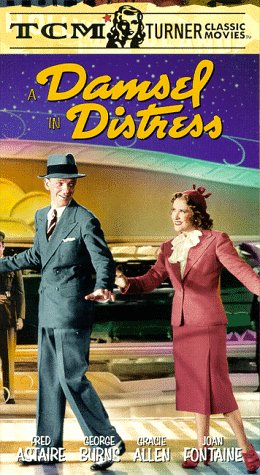- A Damsel in Distress (film)
Infobox Film
name = A Damsel in Distress

caption = "A Damsel in Distress" VHS cover
director =George Stevens
producer =Pandro S. Berman
writer =
starring =Fred Astaire George Burns Gracie Allen Joan Fontaine
music =George Gershwin (songs)
cinematography =
editing =
distributor =RKO Radio Pictures Inc.
released =November 19 ,1937 (U.S. release)
runtime = 98 min
language = English
budget =
amg_id = 1:12020
imdb_id = 0028757"A Damsel in Distress" (
RKO ) is a 1937 English-themed Hollywood musical comedyfilm starringFred Astaire ,Joan Fontaine ,George Burns , andGracie Allen . With a screenplay byP. G. Wodehouse , loosely based on his novel of the same name, music and lyrics by George andIra Gershwin , it is directed byGeorge Stevens .Overview
The film was made at George Gershwin's instigation, an enthusiasm that Wodehouse mischievously attributedcite book
last = Mueller
first = John
title = Astaire Dancing - The Musical Films
publisher = Hamish Hamilton
date = 1986
location = London
pages = pp.126-137
id = ISBN 0-241-11749-6 ] to the fact that his novel was about a successful American songwriter named George Bevan.George Gershwin died of abrain tumour while the film was in production.The first Astaire RKO film not to feature
Ginger Rogers , the nineteen year-old Fontaine was chosen, withBurns and Allen drafted in to provide the comedy. It soon emerged that Fontaine couldn't dance, but Stevens persuaded Astaire not to replace her withRuby Keeler .cite book
last = Thomas
first = Bob
title = Astaire, the Man, the Dancer
publisher = Weidenfeld & Nicolson
date = 1985
location = London
pages = p.148
id = ISBN 0-297-78402-1 ] The film was the first Astaire picture to lose money, costing $1,305,000 to produce and losing $65,000. The "Stiff Upper Lip" routine garnered co-choreographer Hermes Pan the 1937 Academy Award for Best Dance Direction.Key songs and dance routines
The choreography explores dancing around, past, and through obstacles, and in confined spaces.
* "
I Can't Be Bothered Now ": sung by Astaire while executing a tap solo with cane in the middle of aLondon street and escaping on a bus.
* "Put Me to the Test": Astaire, Burns, and Allen comic tap dance with whisk brooms, a routine inspired by vaudeville duo Evans and Evans and introduced to Astaire by Burns, who quipped: "Gracie and I ended up teaching Astaire how to dance".cite book
last = Burns
first = George
title = Gracie: A Love Story
publisher = G.P Putnam and Sons
date =
location =
pages = pp.204-206
id = ]
* "Stiff Upper Lip": sung by Gracie Allen and followed by an innovative extended comic dance by Astaire, Burns, and Allen through a fairground obstacle course.
* "Things Are Looking Up ": Astaire sings one of Gershwin's "most beautiful, yet underappreciated ballads", followed by a romantic dance through the woods with Fontaine, where George Stevens artfully uses trees to hide Fontaine's terpsichorean shortcomings.
* "A Foggy Day (in London Town)": Astaire introduces what has become a standard in theGreat American Songbook , sung while alternately walking and dancing solo through a wooded landscape.
* "Nice Work If You Can Get It ": the film's second Gershwin standard is introduced by Astaire and chorus, followed by an Astaire tap solo, executed while confined by and playing a set of drums. It was shot in one continuous take and makes use of a very early version of thezoom lens .
* The movie also features two faux madrigals written by the Gershwins: "Sing of Spring" and "The Jolly Tar and the Milkmaid". These are performed by a group of madrigal singers, with Astaire joining in on the latter song.Notes and references
External links
*
* [http://www.wodehouse.org/PlumLines/damsel.html Illustrated review (1999) by Michael Skupin] at Wodehouse.org
Wikimedia Foundation. 2010.
